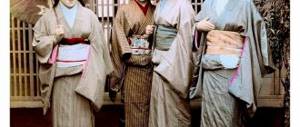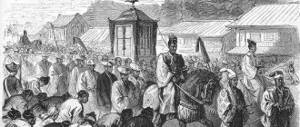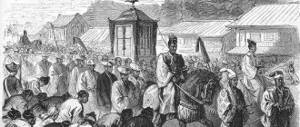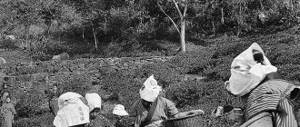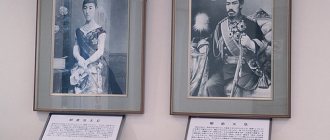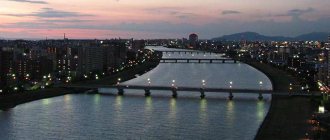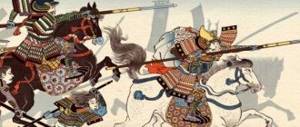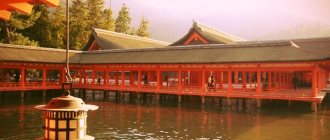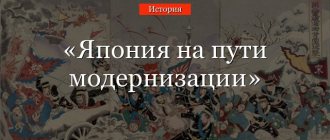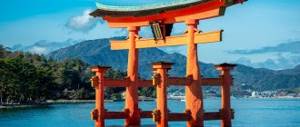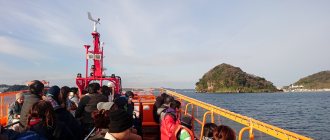On February 3, 1867, the 122nd ascended the throne of Japan. Emperor Mutsuhito, whose reign went down in history as the “era of reforms.”
Our country has a rather vague idea of Japan, both modern and ancient. It is mainly based on various cliches and cliches.
Today's Land of the Rising Sun is not at all similar to the state that experienced its revolution. Moreover, a special one, during which the monarch did not lose power, but, on the contrary, regained it.
For nearly 700 years of Japanese history, the emperor was a deified but essentially figurehead figure. The real ruler of the country was the shogun, which translated means “commander” or “commander”.
Article on the topic
Hirohito's hard day. How the Emperor of Japan became a man
A representative of the most influential Japanese clan became shogun. The title seii-taishogun was hereditary and clannish, although formally it was always complained by the emperor. There was no clear order of succession to the title: usually the shogun appointed a successor from among his sons, but if there were none, he adopted one of the representatives of other branches of the family.
the Tokugawa clan for 250 years . A special code was created for the emperor and his entourage, which ordered the monarch to devote his time to the study of science and the arts.
Emperors almost never left the grounds of Gosho Palace in Kyoto, except when the emperor relinquished power or, in the event of a fire, retreated to the temple's shelter. It was believed that the main duty of emperors was to perform rituals aimed at protecting the country from natural disasters.
Tokugawa Yoshinobu, Osaka, 1867. Photo: Commons.wikimedia.org
Imperial Revolution
The seemingly eternal order of things was called into question in the middle of the 19th century. Japan, like neighboring China, which lived in deliberate isolation, was faced with the Europeans' intention to force it to conclude trade agreements by force of arms.
Economically, socially and militarily backward, Japan could not resist external expansion. The shogun's government entered into treaties that threatened to place Japan in the position of a semi-colony.
Dissatisfaction with this state of affairs began to mature among the Japanese elite. The way out of the situation was seen as returning real power to the emperor.
Tokugawa Yoshinobu, the last shogun of the Tokugawa clan, as well as the last shogun in Japanese history, who took office in 1866, saw a way out of the crisis in government reforms in the European style. However, the shogun no longer had time to implement them. Under pressure from political opponents, on November 9, 1867, Tokugawa Yoshinobu officially announced the return of power to the emperor, who at that time was Mutsuhito . The emperor is known by this name only abroad: according to tradition, after death in Japan, the monarch is called the same as the era of his reign. Mutsuhito's era was called "Meiji", which means "era of reform".
Formation of the anti-Shogun opposition
Under these conditions, the princes, the highest representatives of the samurai class, began to show more and more their hostility towards the shogun and sympathy for the emperor. Some of them no longer took into account the harsh decrees of the shoguns to “close” the country and allowed themselves what they could not afford before. For example, secretly from the government, several small ships based on European models were built, as well as enterprises for the production of glass and iron. Previously, such violations of the stay-at-home order were punishable by death. Now they got away with it because the shoguns had lost their former influence and power. Many samurai, including some princes, were increasingly thinking about restoring imperial power and carrying out reforms along European lines. The impetus for their action was the forced “opening” of Japan by Western powers in the 50s. XIX century
Japanese Civil War
Tokugawa Yoshinobu hoped that the formal abolition of the shogunate would allow him to simultaneously maintain his clan in power. However, political rivals turned out to be stronger. The new government was formed by opponents of the shogunate. On behalf of the emperor, it adopted a decree abolishing the shogunate and restoring direct imperial rule. The new government stripped the ex-shogun of all his titles and most of his landholdings. In response, Yoshinobu moved from Kyoto to Osaka Castle, where he began preparations to overthrow the opposition and return to power.
Troops of the Tokugawa shogunate (1864). Photo: Commons.wikimedia.org
As often happens in history, a revolutionary change of power was followed by a civil war, known in Japanese history as the Boshin War.
The armed conflict, which began in January 1868, ended in May 1869 with the complete defeat of the supporters of the shogunate.
It must be said that the Boshin War was quite moderate in terms of the number of casualties. The conflict, which involved approximately 120,000 people on both sides, resulted in approximately 4,000 deaths.
For the last shogun, this defeat only resulted in house arrest, from which he was released after a relatively short period of time. Tokugawa Yoshinobu was restored to a number of privileges, and in 1902 he was granted the title of duke, included in the new Japanese kazoku aristocracy and given a seat in the House of Peers of the Imperial Diet of Japan. However, the shogun, who lost power, moved away from politics, devoting his life to photography, hunting and the game of Go.
The young Emperor Meiji with foreign representatives at the end of the war. Photo: Commons.wikimedia.org
"Five Point Oath"
Even before the victory in the Boshin War, Emperor Mutsuhito proclaimed the program of his reign in the form of the so-called “Five Point Oath”:
1. We will convene meetings and govern the people, taking into account public opinion.
2. People of higher and lower classes, without distinction, will be unanimous in all undertakings.
3. Civil and military officers will be treated in such a way that they will be able to perform their duties without dissatisfaction.
4. Outdated methods and customs will be destroyed, and the nation will follow the great Path of Heaven and Earth.
5. Knowledge will be borrowed from all nations of the world, and the Empire will reach its highest point of prosperity.
Mutsuhito's behavior was also revolutionary. He left the imperial palace to personally lead the troops fighting the supporters of the shogunate. Mutsuhito became the first emperor in many centuries whom the Japanese could observe closely: he traveled around the country to familiarize himself with the state of affairs on the ground.
The sixteen-year-old emperor moving from Kyoto to Tokyo (1868). Photo: Commons.wikimedia.org
In September 1868, Mutsuhito renamed the city of Edo Tokyo. The formal coronation of the emperor took place on October 15, 1868. It was then that the monarch proclaimed the beginning of the Meiji era.
Japan was faced with an extremely difficult task: to quickly rebuild the state so that it could be competitive.
Article on the topic
The power of PR: how one man defeated Japan and the USA
New order
The government of the state was taken over by the State Council, composed of ministers. By 1885, the structure of the government was as close as possible to the European one, and the post of prime minister was introduced. The emperor took part in meetings of the cabinet of ministers, but spoke very rarely himself.
The system under which local government was concentrated in the hands of daimyos, sovereign princes, was abolished. Some daimyo transferred their possessions to the emperor voluntarily, while others had their lands taken away.
In 1871, by decree of the emperor, the autonomous regions were abolished, and the country was divided into 72 prefectures. The daimyo received high monetary rewards and were required to move to the new capital, Tokyo. Many of them left political posts.
In 1868, the abolition of workshops and guilds was proclaimed and the right to freely choose a profession was granted to everyone. The entire Japanese population received the right to free movement throughout the country. Formal equality of all classes before the law was introduced and the right of private ownership of land was established, a unified land tax was established, replacing numerous feudal taxes.
Young Emperor Meiji in military uniform (1873). Photo: Commons.wikimedia.org
A parliament was created in the country, but it did not have real power: at the beginning of this period, Japan remained an absolute, not a constitutional monarchy.
The Japanese army began to rebuild at an accelerated pace according to European canons. This happened during the “Boshin War”, and after its end the process acquired an even larger scale.
After the liquidation of the principalities, their troops, consisting of samurai, were reassigned to the Ministry of War. In 1873, the government introduced universal conscription in the country. From now on, all men who reached the age of twenty were required to serve in the army, regardless of their social origin.
Simultaneously with the military reform, police units separate from the army were created.
Art
The “discovery” of Japan with the Meiji Restoration initiated a more substantive interest of Europeans in Japanese culture, which was embodied in the phenomenon of “Japanism” at the turn of the 19th and 20th centuries. In Western Europe, the real fascination with Japan began after the Paris World Exhibition (1867), where, in addition to examples of decorative and applied art already known to the general public, masterpieces of Japanese graphics and painting were shown.
After the Paris World Exhibition, Japan continued to take an active part in world exhibitions (Vienna World Exhibition - 1873, World Exhibition in Philadelphia - 1876), actively popularizing Japanese art in the foreign market and gaining increasing success.
Thus, starting from the Paris Exhibition, famous French painters - Edouard Manet, Edgar Degas, Paul Gauguin and Vincent Van Gogh - became interested in Japanese engravings and graphics. French writers and art critics, the Goncourt brothers, played a major role in the promotion of Japanese art at this stage. The Japanese theme finds a specific reflection in European literature at the turn of the century, primarily in the new genre of the so-called colonial or “exotic” novel.
It also affected the art of music, inspiring fin-de-siecle composers (Giacomo Puccini, Maurice Ravel) to create unique musical images that exquisitely refract the Japanese artistic tradition.
The tendencies of “Japanism” were embodied with particular vividness in the works of the Vienna Secession artists Gustav Klimt and Joseph Hoffmann, transforming the iconography of Austrian Art Nouveau not only with ornamental motifs, but also with images, plots, and, ultimately, with writing techniques previously rarely seen among European masters.
In connection with the increased and systematic interest in the art of Japan during this period, the foundations of European Japanese studies were laid.
Porcelain
Among the types of Japanese decorative and applied art, it is Japanese ceramic products that are most famous in the West due to their sophistication, color, symbolism, special painting and decorative elements, while the laconicism of the expressive means of traditional ceramics, the integrity of forms, the organic nature and living asymmetry of the decor corresponded to European artistic searches second half of the 19th century.
The style of Japanese ceramics should be considered a set of features that characterize ceramic objects from a certain region or center of production. Thus, with the beginning of the Meiji period, the style of products made in the vicinity of Imari-Arita was finally called Arita. It is characterized by painting in cobalt blue with abundant addition of red and gold enamels. To the main blue underglaze painting, painting with gold paints was added.
However, the leading style of ceramics during the Meiji era was the Satsuma style. This style is characterized by a milky-white shade of the ceramic mass, painted with bright multi-colored enamels on a glaze with craquelure. The subjects include images of animals, birds, fish, shells, flowers, historical figures, battle scenes, mythological characters, samurai, geisha, subjects of literary works, scenes of holidays, famous views of ancient cities.
One of the characteristic techniques of the Satsuma style is the widespread use of openwork carving. Relief, embossing, painting with thick paints creating relief lines, and gilding were often used.
Famous artists who worked in the Satsuma style are Kinkozan Sobei VI (1824-1884), Kinkozan VII (1867-1927) and Miyagawa Kozan (1846-1916), whose works were widely represented on the foreign market. The growing demand for Japanese ceramics abroad gave rise to the production of ceramic and porcelain products for export to Europe, such as tea and coffee sets, formal dishes, large floor vases and others.
Metal products
During the Meiji period, significant changes occurred in the art of Japanese metal craftsmen. In Japan, bronze casting was associated primarily with the needs of Buddhism, while metal forging and engraving related more to military devices, especially the manufacture of metal fittings for samurai swords.
However, with the beginning of the Meiji period in 1868, the samurai class was abolished, and in 1876 a decree was issued banning the wearing of swords, which in turn significantly transformed the work of metalworkers who had to change the content and methods of work accordingly. At the same time, significant changes in religious life, such as the reduction in the number of Shinto and Buddhist temples, led to a decrease in demand for temple bells, Buddhist statues and many other religious objects. As a result, a significant number of highly qualified craftsmen began to look for new ways to develop art and new areas of application of professional skills, adapt the production of metal products to changing realities and bring it closer to other related crafts.
Thus, some craftsmen who specialized in creating sword frames began to make guards (tsuba) as a separate work of decorative and applied art. Such tsubas, or entire sets of sheath fittings—minus the blades themselves—have become collectibles in both Japan and the West. Other artists were looking for new areas of application of metal decoration techniques. Large workshops and trading companies were opened in Japan, specializing in vases, incense burners, boxes, cigarette cases and decorative metal plastic; Traditional techniques and themes were widely used in their decoration. The Japanese craftsmen who created the sword mount parts used a wide variety of alloys, the bases of which were mainly gold, silver, iron and copper. To obtain a variety of colors, tin, zinc, and lead were added to the alloys - in total, at least eight basic metals and alloys are known.
The most commonly used alloys were shibuichi (an alloy of silver and copper) and shakudo (an alloy of gold and copper), which produced a wide palette of colors - from deep gray with an olive tint to black with a violet tint, depending on the proportions of the metals in the alloy. Among the famous masters of the Meiji era are Ishiguro Koretsune, Miyake Terumitsu, Nakamura Ikko Tsunetika, Kobayashi Chikamitsu, Kogyokusaya Ikkyu, Kajima Ikkoku, Akasofu Gyoko, Yoshimitsu, Genryusai Seiya, Oshima Joun, Jomi Eisuke II, Suzuki Chokichi, Shoami Katsuyoshi, Kano Natsuo, Unno Shomin, Otake Norikuni, Namekawa Sadakatsu.
Japan's successful participation in world fairs provided the impetus for the arts and crafts industry to become a profitable export industry. An Exhibition Bureau was organized, functioning under the control of the Ministry of Internal Affairs of Japan, monitoring the quality of products and helping outstanding artists in their creative activities; A trading company was created, which acted as a state exporter of works of Japanese decorative and applied art.
Enamels
The Meiji period is the time of the “Golden Age” of Japanese enamel. Enamels in Japan are called sippo, which in Japanese means “seven treasures”: gold, silver, emerald, coral, diamond, agate and pearl. Later, the term sippo began to be used by the Japanese to refer to works with enamel decoration.
The main technique used to decorate enamel works was the yusen-sippo technique (clisonné enamel technique). A design was applied to a base made of copper alloy or bronze, then its outline was outlined with a thin metal strip, glaze was poured into the cells formed between the partition strips, then fired and polished. The partitions served a dual function: they could be part of the composition as a decorative element, while at the same time preventing the molten enamel from spreading into adjacent areas of the composition.
Cloisonne enamel is found in different techniques. Musen technique, in which the partitions were removed; Shosen technique - in which part of the partitions remained visible, and part was hidden. The Moriage technique was also used, which created the effect of a relief convex image from layers of enamel.
Among the largest enamellers of that time were the namesakes Namikawa Sosuke and Namikawa Yasuyuke. Both belonged to the circle of elite artists, especially noted by the imperial court.
Japanese craftsmen actively participate in international exhibitions and cloisonne enamels are becoming one of the important works of decorative and applied art. In general, Meiji era enamels were in enormous demand in European and American markets and were produced more for export.
Lacquered products
The economic difficulties of the Edo period led to a decrease in demand for lacquerware decorated with gold or silver. The Meiji era saw renewed interest in lacquer as artists developed new designs and experimented with new textures and finishes.
The first of these was Shibata Zeshin, who was called "the greatest master of lacquerware in Japan." The appeal of his original style lay in the choice of motifs and subjects rather than in the use of gold and silver. He placed lacquer panels in frames, imitating Western oil paintings. Other notable artists of this period include Nakayama Komin and Shirayama Shosai, who adhered to a classical style that owed much to Japanese and Chinese landscape art.
The most common technique for lacquerware was the maki-e technique, which is characterized by the use of gold and silver powder sprinkled onto uncured varnish.
Richly decorated lacquerware with original designs was popular both domestically and internationally. And Japanese varnishes have gained worldwide fame due to their highest quality and special manufacturing techniques.
Textiles and clothing
The modernization of the Meiji era radically changed manufacturing technology and introduced the country to new types of fabrics. Woolen cloth, so necessary for the army and navy, was not produced at all in Japan. Modernization of the industry began with the largest factories.
The Nishijin company, the main manufacturer of silk fabrics in the country, refocused on the industrial production of fabrics. However, home workshops also continued to operate, where the traditions of weaving brocade and patterned silks according to ancient patterns were preserved.
At the same time, every region, every settlement, every weaver kept the family craft secrets of fabric making. Hyogo and Aichi prefectures were famous for cotton fabrics, Fukui Prefecture for habutae silk, Niigata Prefecture for silk crepe (chijimi), Gunma, Tochigi and Tokyo prefectures for silk fabrics, and Aomori and Iwate Prefectures for hisizashi fabrics with white thread embroidery.
During the Meiji era, two terms emerged: wafuku (Japanese clothing) and yofuku (European-style costume). Items from Japanese and Western clothing were mixed, sometimes giving rise to bizarre combinations.
The development of kimono during this period was closely related to the introduction of new technologies for applying patterns to fabric and dyeing materials with various types of dyes. Many types of coloring began to be produced by machine using stencils. Technological advances have expanded the ability of textile artists to create striking new patterns to suit modern tastes.
The Emperor experienced the first railway in Japan
In 1876, the Japanese government decided to begin the practice of calculating pensions for nobles. Up to a third of the state budget was spent on state support for this class. The nobles left without funds were forced to switch to government service or engage in entrepreneurship.
Article on the topic
Sex slaves for the emperor's soldiers. How Japan is paying for old sins Large-scale land and tax reforms were carried out. In 1872, the ban on the sale of land was lifted and the existence of private property was recognized. Instead of the previously existing quitrent in kind, the state began to receive a cash tax from landowners in the amount of 3% of the value of the land plot.
In 1871, the Ministry of Culture was created, the central institution responsible for educational policy. In 1872, it decreed a public education system based on the French model. However, the authorities soon came to the conclusion that creating an education system modeled on France was too difficult, and in 1879 a decree “On Education” was issued, according to which compulsory public education was limited only to a German-style elementary school. For the first time, state educational institutions appeared where boys and girls studied together.
Kaichi School is the oldest elementary school in Japan. Photo: Commons.wikimedia.org
In 1877, the University of Tokyo was founded, and pedagogical institutes and higher education institutions for women were actively created in the prefectures.
With the help of Europeans and Americans, a large-scale project to industrialize the country began to be implemented. In 1872, under the direction of European engineers, the first railway was opened, connecting Tokyo with Yokohama. The locomotives were brought from Europe, and the station building was designed in the USA. The first passenger was the emperor himself.
In 1877 and 1881, industrial exhibitions were held in the country to introduce promising global technologies in industry and agriculture. In 1877, Alexander Bell established a telephone line between Tokyo and Yokohama.
Article on the topic
Russian Apostle of Japan. How Father Nikolai converted the Japanese to Orthodoxy
The wooden buildings traditional in Japan were replaced by solid stone houses.
Constitution of the Empire
Industrial enterprises were founded like mushrooms after rain. In the recently closed Japan, fashion for European clothing and a European lifestyle appeared. True, many believed that this was damaging to traditional values, and such fears were not unfounded.
In 1872, Japan switched to the Gregorian calendar, and newspapers and magazines began to be published in the capital. Foreign delegations were received in Tokyo, and a special ceremony was developed for the meetings of guests with the emperor, which, while emphasizing the importance of the figure of the monarch, should at the same time not affect the dignity of foreigners.
The Emperor of Japan receives the French military delegation at the Kyoto Imperial Palace. Photo: Commons.wikimedia.org
In the international arena, Japan sought to revise enslaving trade agreements and create an equal partnership.
In 1889, the Constitution of the Empire of Japan was introduced. In addition to defining the fundamentals of the legal status of the emperor and executive authorities, it established a list of fundamental rights and freedoms of Japanese subjects, introduced into the system of government bodies a parliament with legislative power, the lower house of which was elected by the population, and also established an independent court. The Constitution came into force in 1890.
Emperor Meiji in 1890. Photo: Commons.wikimedia.org
End of isolation
Since 1639, Japan, by the will of the ruling Tokugawa shogunate, has remained relatively closed from the outside world. She maintained some contacts with China, Korea and Holland, but categorically refused to negotiate with France, Russia and Great Britain.
In the 1850s, Americans made their way to Japan. For them, this island state was an important transit point during the European crisis in the Far East and a base for strengthening the US position in China. In addition, the development of whaling required the development of remote ports. In 1853, American merchant and warships approached the Japanese shores and, under the threat of shelling of the capital of Edo, forced the shogun to enter into an agreement that allowed the Americans to enter two Japanese ports.
Soon similar agreements were concluded with Russia, Holland, France and Great Britain, and in 1858 the United States forced Japan to sign an enslaving agreement limiting its customs, international, and trade autonomy. Once again, other countries followed the US example.
The Great Break
The Meiji era was a turning point for Japan. Over the course of a couple of decades, the country transformed from a backward feudal state into an advanced capitalist power that began to challenge its neighbors. Not everyone was ready for this: for Russia, defeat in the Russo-Japanese War of 1904-1905 was a bitter revelation.
The ambitions of the Japanese elite began to grow by leaps and bounds. The downside of the progress of the Meiji era was plans for large-scale colonial expansion and the growth of Japanese militarism. These processes will reach their peak during the Second World War.
This, however, no longer applies to the story of Mutsuhito, the 122nd Emperor of Japan, who left this world before the outbreak of World War I: July 30, 1912.
The New York Times, describing the farewell ceremony for the emperor, wrote this: “The contrast between what walked in front of the funeral wagon and what walked behind it was truly striking. Old Japan came before her, new Japan followed her.”
Results
The Meiji Revolution led to the growth of Japan's military and industrial power. Now the state, which until recently was considered by the Western powers as a potential raw materials appendage or supplier of cheap labor, has itself become involved in the struggle for the colonial redistribution of the world. Despite the initial refusal to conquer Korea, which led to the rebellion of Takamori Saigo, the ambitions of the Japanese nobility grew. A militaristic regime began to take shape in Japan, headed by an absolute monarch. Perhaps the democratic seed contained in the reforms would later grow into a constitutional monarchy on the model of Great Britain, but these processes were interrupted by two world wars.
The development of capitalism was also dualistic. On the one hand, huge monopolies flourished, military enterprises and railways were built, and on the other, the exploitation of peasants and workers intensified. Industry ensured the growth of military potential, but did not provide the population with consumer goods and products, which led to the “rice riots” in 1918.
But even these contradictions do not negate the fact that for Japan the Meiji Revolution was a colossal breakthrough that placed it among the leading world powers.

